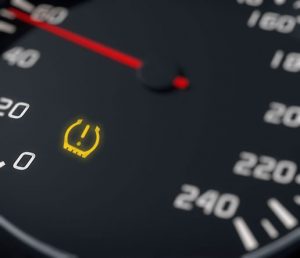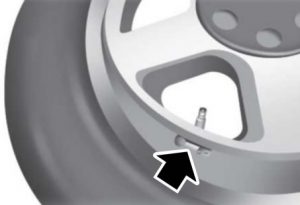A ‘direct’ battery powered wireless sensor inside each tyre relays air pressure information typically via radio frequency back to the car’s computer. The tyre pressure dashboard warning light is usually triggered when a pressure loss of around 25% or more is detected.
An ‘indirect’ tyre pressure monitoring system does not have sensors inside the tyres and instead uses ABS wheel speed sensors to detect low tyre pressures.
Even if your car comes equipped with a tyre pressure monitoring system, it’s still important to regularly check pressures as the system will only alert you when the issue becomes hazardous. Maintaining correct tyre pressure is important; underinflated tyres increases tyre wear, increases fuel consumption and if you are running with unequal/incorrect pressures, it will decrease vehicle stability.
From 1st November 2014, EU regulations have made it mandatory for all new-build cars to be fitted with tyre pressure monitoring systems, or ‘TPMS’. This does of course mean that by now, there are many more vehicles on the road equipped with TPMS and as with all things technological, it also means there’s more things to go wrong.
When the tyre pressure warning light illuminates on your dashboard, you’ll obviously need to check tyre pressures of all four tyres and not forgetting the spare if you have one. If you’re not sure what the pressure should be, check the tyre pressure label, look for information in the car owners manual, or if you’re still no wiser, contact the dealer where you purchased your car for information.
Problems arise when tyre pressures are just fine, but yet that tyre pressure symbol is still illuminated on the dashboard. Let’s look at some of the common faults and remedies.

Tyre Pressure Light Stays On
Assuming tyre pressures have been checked, yet the dash light won’t go off will often suggest a fault with one of the pressure sensors or a faulty / dead battery. Due to the tyre pressure monitoring system being sealed, the entire defective unit will require replacement.
Tyre Pressure Sensor Battery
The battery is sealed within the TPMS unit and therefore cannot be replaced. Tyre pressure monitor batteries last anywhere up to around 10 years, but realistically you can expect a lifespan of 5 to 6 years. The more miles you do, the quicker the battery will die and in terms of miles, you can expect the battery to last up to 100,000 miles. Battery-free tyre pressure monitor sensors are being developed which will go some way into reducing waste, servicing / replacement costs and weight.

Tyre Pressure Light Coming on in Cold Weather
Inside a tyre, the air pressure will drop in cold weather. If it’s a particularly cold day and your tyre pressure warning has come on, it’s likely that the air pressure has fallen below the TPMS threshold, triggering the warning. Simply add air to your tyres, being careful not to over-inflate.
Tyre Pressure Light Goes On and Off
Again due to external temperatures, this is usually due to colder climate lowering tyre pressures to the TPMS threshold. As you drive, the tyre will warm increasing the pressure and will fall below the threshold when cool again.
Tyre Pressure Light Flashing
A flashing or blinking tyre pressure warning light will usually indicate a fault or the battery in one or more units requires replacement.
Tyre Pressure Warning Light and the MOT
A faulty tyre pressure monitoring system will usually result in an MOT failure. Regulations from 1st January 2015 require that any car manufactured from 2012 onwards that is displaying the TPMS light on the dashboard will fail the MOT test.
Tyre Pressure Warning Light Reset
Before resetting the tyre pressure warning system, ensure pressures are correct else the warning will reappear. TPMS reset is different on all vehicles and it’s likely you’ll need to enter system settings and scroll through a menu to find TPMS options.
How to Monitor Tyre Pressure
If your car doesn’t come equipped with TPMS and you want some means to monitor tyre pressure, an easy and affordable option is tyre pressure monitoring valve caps. These are cheap and simply require swapping over your existing plastic valve caps on your wheels. Depending on the pressure, they will display a colour to indicate tyre pressures are good, need attention or are low.

Hi, I’ve recently had two front tyres put on my Honda Civic ex gt and I travelled all the way to Blackpool from the midlands with no problem, but on the way back the tyre monitoring system warning light came on, so I stopped at a service station and checked my tyres, they all looked ok and didn’t look flat, I’ve put an equal 35psi in them all and the light will not go off, could it be one of the new tyres I had fitted two days previous? Regards Steve.
Hi Steve,
Did you reinitialise the tyre pressure monitoring system?
Using tyres that are not recommended, such as the same brand, model and size can cause issues.
honda monitoring systems are badly built so honda ingenuously blames the owner or the tyres, even though they are exactly the same pressure, manufacturer, dimensions. Only recourse is to trade in for a more reliable make.
I have an Audi A3 s-line. It doesn’t have TPMS sensors but the light keeps coming on all the same. I had my car booked in to have all the alloys re diamon cut & powder coated, so the day before took it to National tyres for a full set of tyres. I explained to them about the light and they said oh could just be faulty valves, we’ve fitted new ones anyway! So you’d think that these guys would know my car doesn’t have the sensors wouldn’t you? Clearly not! Anyway, took the car to the powder coaters …. And told him all of the above, he instantly said, your alloy is buckled, but I’ll check it when I take the wheels off. He called me an hour later, the wheel is bucked and that’s what’s caused the light to keep coming on. The damage was likely caused when I hit a pot hole and the tyre burst a couple of months ago, All the same, wouldn’t you think that when I had the tyres done, they’d have noticed the buckle? Or the fact that I don’t have TPMS sensors!
Hi Gabriella,
When you say your Audi doesn’t have TPMS sensors, I assume you mean it uses the ‘indirect’ system that uses the ABS sensors to measure rotational speed? TBH, National Tyres just went through the process of changing the tyres as quickly as possible and didn’t even give a thought to whether or not the wheel was buckled. Even when balancing the wheel, you can balance it even if it’s buckled. But yeah, would be nice if they took a bit more care and effort. A buckled wheel will certainly throw off an indirect TPMS.